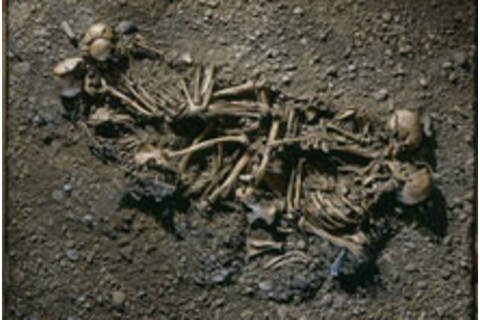
About 4,600 years ago in Germany's fertile farm country a group of stone age people met a violent end, but the arrangement of their skeletons in four graves tells a story of love and family bonds. One particularly well-preserved grave holds what researchers say is the first known nuclear family, with an adult male and female cradling the bodies of their two sons. A DNA analysis of the skeletons' bones and teeth confirmed their blood ties:
"The two kids have her mitochondrial DNA, and his Y chromosome - that's a nuclear family," says molecular anthropologist Brian Kemp [New Scientist].
The group of 13 individuals includes adults aged 25 to 60 and children under the age of 9, and researchers believe that they were massacred. Says study coauthor Alistair Pike:
"They were definitely murdered, there are big holes in their heads, fingers and wrists are broken." At least five of the individuals show the effects of a violent attack, one even had the tip of a stone weapon embedded in a vertebra [BBC News].
The findings, reported in the Proceedings of the National Academy of Sciences [subscription required], shed light on how prehistoric people lived.
Many anthropologists have assumed, based on observations of sometimes polygamous modern-day hunter-gatherers, that the basic social unit of early humans was the band or tribe rather than the family [ScienceNOW Daily News].
But these ancient people, who are thought to have lived in agricultural settlements, may have valued the stability of nuclear families, researchers say. Study coauthor Wolfgang Haak says that the presence of older adults and young children in the graves may indicate that only part of the community was killed in the attack, which may have been provoked by competition for fertile farmland.
Adolescents and young adults were either not present — perhaps they were working in fields — or were able to escape, while younger children and older adults were killed. But then the survivors returned and, with intimate knowledge of the relationships among the dead, properly buried them [The New York Times].
Related Content: 80beats: Stone-Age Graveyard in the Sahara Recalls an Era of Lakes and Wetlands DISCOVER: Stone Age Social Security DISCOVER: Origins of Farming UnearthedImage: National Academy of Sciences, PNAS













